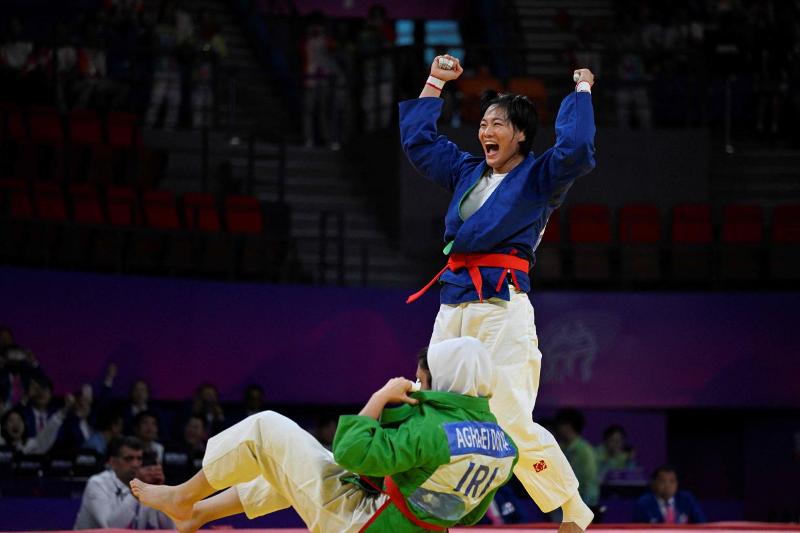Get ready to be mesmerized by the thrilling world of Kurash, a martial art that's making waves at the Asian Games. Find out how this ancient practice has caught the attention of new fans and competitors, and witness the captivating performances that are taking the stage by storm.
What is Kurash?
Discover the origins and essence of Kurash, a centuries-old martial art.
Kurash, a fascinating martial art originating from Central Asia, has now gained global recognition at the Asian Games. It traces its roots back centuries and was traditionally associated with wedding ceremonies and ancient warriors.
In Kurash, participants wear distinctive green and blue jackets, aiming to throw their opponents to the ground without utilizing ground moves. Its unique aspects, along with an influx of new participants from unlikely countries, make it a captivating and thrilling sport to watch.
Kurash's Rise at the Asian Games
Uncover the journey of Kurash as a medal event at the Asian Games and its growing popularity.
Kurash recently became a medal event at the Asian Games, making its debut in Jakarta in 2018. Its inclusion has opened the door for athletes beyond the Central Asian heartlands to showcase their skills on the international stage.
Hundreds of competitors have enthusiastically transitioned from disciplines like judo. Though many faced experienced opponents from Uzbekistan, known to dominate the sport, their enthusiasm and dedication remain undeterred.
The Intricacies and Techniques of Kurash
Delve into the techniques and nuances that make Kurash a technical and breathtaking martial art form.
Kurash revolves around precise techniques and continuous improvement. Participants execute throws that emphasize control, force, and speed. Each bout commences and concludes with opponents bowing to each other as a display of respect.
Kurash vs. Judo
For some athletes who transitioned from disciplines like judo to Kurash, adapting to all-standing takedowns was a significant adjustment. Unlike judo, where ground games play a pivotal role, Kurash exclusively focuses on standing takedowns, requiring athletes to rethink their strategies and game plans.
Showcasing Kurash on the World Stage
Witness the impressive performances of Kurash athletes from lesser-known nations showcasing their talent at the Asian Games.
Traditionally, Kurash has seen domination from countries like Turkmenistan, Kazakhstan, and Uzbekistan. However, China's recent victories, including Yu Dan's historic gold medal win, have demonstrated the sport's expanding reach. Yu Dan became China's first-ever Kurash gold medallist, captivating home fans and shining a spotlight on this captivating martial art.
The Asian Games also present a platform for athletes from other countries like the Philippines to showcase their skills and promote Kurash within their homelands. The sport's growing popularity globally speaks to its universal appeal and captivating nature.
The Legacy and Future of Kurash
Explore the future of Kurash and its potential to grow as a beloved sport among martial arts enthusiasts worldwide.
The Asian Games serve as the perfect avenue for athletes to leave a lasting legacy in lesser-known sports like Kurash. With its demanding technicalities and the challenge it poses to athletes, Kurash will continue to intrigue martial arts enthusiasts and increase its flexibility and credibility as a thrilling sport to watch.
International institutions, like Kurash Women Commission, continue to support and nurture the growth of the sport. It has opened the door for more countries to participate, promoting inclusivity and ensuring the enduring legacy of Kurash across the global martial arts community.
Conclusion
Kurash, the ancient martial art once rooted in traditional ceremonies and the battles of old, has captivated audiences at the Asian Games. What was once a little-known discipline has now become a thrilling event, drawing in new fans and competitors from across the globe.
As countries outside the traditional heartlands of Kurash continue to embrace the sport, the Asian Games has played a significant role in catapulting its popularity. With its unique standing takedowns and demands for continuous improvement, Kurash showcases the rich diversity and remarkable skills of its participants.
The future of Kurash shines bright as athletes from unexpected nations emerge and carve their path to success. With each breathtaking throw and monumental victory, the legacy of Kurash as a beloved martial art is ensured for generations to come.
FQA :
What are the origins of Kurash?
Kurash originated from Central Asia and has a historical association with wedding ceremonies and ancient warriors.
How did Kurash become a part of the Asian Games?
Kurash made its debut as a medal event at the Asian Games in 2018, allowing athletes from various countries to showcase their skills on an international platform.
What sets Kurash apart from judo?
Unlike judo, Kurash focuses on all-standing takedowns and does not involve ground games. This requires athletes to adjust their game plans and strategy accordingly.
Who are some notable performers in Kurash at the Asian Games?
Countries like China have produced Kurash gold medallists, such as Yu Dan, bringing attention to the sport and inspiring athletes from their respective nations.
What is the future of Kurash?
Kurash continues to captivate martial arts enthusiasts worldwide with its technical brilliance. With growing inclusivity and supportive institutions, the sport is set to thrive and leave a lasting legacy.

